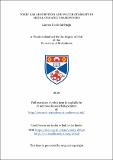Files in this item
Toxic gas adsorption and water stability in metal-organic frameworks
Item metadata
| dc.contributor.advisor | Morris, Russell Edward | |
| dc.contributor.author | McHugh, Lauren Nicole | |
| dc.coverage.spatial | xv, 240 p. | en_US |
| dc.date.accessioned | 2019-11-05T12:51:04Z | |
| dc.date.available | 2019-11-05T12:51:04Z | |
| dc.date.issued | 2019-12-03 | |
| dc.identifier.uri | https://hdl.handle.net/10023/18848 | |
| dc.description.abstract | This thesis largely focuses on the development of water stable metal-organic frameworks (MOFs) for the removal of toxic industrial chemicals (TICs) from airstreams. The aim of the research is to investigate the water stability and adsorptive properties of a series of copper MOFs for potential use inside a filter in future air purification systems. Chapter 4 introduces a member of the STAM series of MOFs: STAM-17-OEt, which has formed the main focus of the project. STAM-17-OEt displays exceptional hydrolytic stability and ammonia adsorption properties that are in part explained by the new crumple zone mechanism shown by the material. The other members of the STAM series of MOFs are presented in chapter 5, where the long-term water stability first seen in STAM-17-OEt is shown to be present for other members of the series. Ammonia adsorption testing provides promising results, with a clear linear adsorption trend visible across the series, and though the materials remove hydrogen cyanide from an airstream, testing does not show a clear trend. Chapter 6 describes the synthesis of MOF-activated carbon composite materials, where selected STAM MOFs are grown inside BPL activated carbon at a series of loadings. The composites allow a typically powdered MOF sample to be manufactured into a form that may potentially be used inside a filter and by altering the loading of MOF within the composites, the materials may be tailored to remove a broader range of contaminants than the individual components alone. Chapter 7 discusses the synthesis and characterisation of two new copper frameworks, where STAM-NMe2 is a member of the STAM series with a nitrogen-containing side chain and copper-1,3-bis(4-carboxyphenyl)-5-ethoxybenzene forms as a ‘layered coordination framework’ and is not related to the STAM series. | en_US |
| dc.description.sponsorship | "Thank you to the EPSRC (grant number EP/N50936X/1) and Dstl for funding this project" -- Acknowledgements | en |
| dc.language.iso | en | en_US |
| dc.publisher | University of St Andrews | |
| dc.relation | Toxic gas adsorption and water stability in metal-organic frameworks (Thesis data) McHugh, L.N., University of St Andrews, 2021. DOI: https://doi.org/10.17630/c7b0027d-b2d4-4f67-984f-a63834197d5c | en |
| dc.relation.uri | https://doi.org/10.17630/c7b0027d-b2d4-4f67-984f-a63834197d5c | |
| dc.subject | Metal-organic frameworks | en_US |
| dc.subject | Porous materials | en_US |
| dc.subject.lcc | QD882.M5 | |
| dc.subject.lcsh | Supramolecular organometallic chemistry | en |
| dc.subject.lcsh | porous materials | en |
| dc.subject.lcsh | Adsorption | en |
| dc.title | Toxic gas adsorption and water stability in metal-organic frameworks | en_US |
| dc.type | Thesis | en_US |
| dc.contributor.sponsor | Engineering and Physical Sciences Research Council (EPSRC) | en_US |
| dc.contributor.sponsor | Defence Science and Technology Laboratory (Great Britain) | en_US |
| dc.type.qualificationlevel | Doctoral | en_US |
| dc.type.qualificationname | PhD Doctor of Philosophy | en_US |
| dc.publisher.institution | The University of St Andrews | en_US |
| dc.identifier.doi | https://doi.org/10.17630/10023-18848 | |
| dc.identifier.grantnumber | EP/N50936X/1 |
This item appears in the following Collection(s)
Items in the St Andrews Research Repository are protected by copyright, with all rights reserved, unless otherwise indicated.

